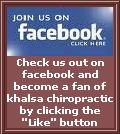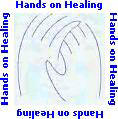

| Home | Dr. Mha Atma's Health Newsletter | Ideas for Good Health | Patient of the
week |
| >About |
| >Meet The Doctor |
| >Meet The Team |
| >Testimonials |
| >Hall of Fame |
| >Upcoming Schedules |
| >Contact Us |
| >New Patient Forms |
| >Exercises |
| >Links To Better Health |
| >Videos |
| >What is Chiropractic? |
| >Why go to Chiropractor? |
Healthy Life Newsletter May 2016
Chiropractic adjustments superior to nerve root injections for treatment of cervical (neck) disk herniation with neck and arm pain
Read the abstractResearchers at Orthopedic University Hospital Balgrist, University of Zürich, Switzerland treated 104 patients with MRI-confirmed cervical disk herniation and associated symptoms--half of them with chiropractic adjustments and the other half with cervical nerve root injection blocks. Three months after treatment 86.5% of the chiropractic patients reported they were "better" or "much better" while 49% of the recipients of nerve root injections reported the same.
---------------------------
Chiropractic treatment for hip arthritis pain
Researchers at the University of Southern Denmark evaluated 118 patients with clinical and x-ry confirmed one-sided hip osteoarthritis and had experienced hip pain for at least three months. Patients were divided into three groups for six weeks of treatment. One group received Hip School education taught by an experienced physical therapist. The second group attended Hip School and also received twice weekly treatments from an experienced chiropractor. The third group did only a home stretching program. The group receiving chiropractic care experienced significantly greater pain reduction than the other groups, and 12 months later the difference was maintained.
http://dx.doi.org/10.1016/j.joca.2013.06.009
---------------------------
Probiotics boost weight loss and immune system and reduce anxiety
Much research is being published demonstrating that the 1,000 species of bacteria and other microorganisms that inhabit your digestive tract have far-ranging effects on your health. Some studies show that taking probiotic supplements, which typically contain one to several species of these bacteria, can enhance health in different ways. Researchers at the University of Turkey placed 77 obese children on a month-long weight-loss diet. Half the subjects also took a daily probiotic supplement. The children taking the supplement lost on average almost three times more weight than the others, and also showed decreases in total cholesterol and free-radical stress. A study by French researchers gave probiotic supplements to 100 men and women aged 60 to 74 in 10-day intervals over four months. Probiotics increased immune function markers and resulted in fewer respiratory infections compared to the plaebo group. And in another study in Genoa Italy, 76 children with recurrent throat strep infections were given a probiotic supplement and 54 children with the same problem were given a placebo. Children taking the supplements had fewer infections than before they started and fewer than the placebo group and continued to have fewer infections nine months after the supplement was discontinued. In one more study, researchers at the College of William and Mary in Virginia asked 710 ethnically diverse young men and women to complete a questionnaire that was analyzed in terms of neuroticism, social anxiety and fermented food consumption. The fermented foods included yogurt, kefir, miso soup, sauerkraut, tempeh and kimchi. They found that the consumption of these foods was associated with lower levels of social anxiety. Previous research has found that some types of probiotics reduce the stress response.
Beneficial Microbes, 2015;6:775-781
Immunity and Ageing, 2015;12:24 doi 10.1186/s12979-015-0051-y
Therapeutics and Clinical Risk Management, 2016;12:87-92
Psychiatry Research, 2015;228:203-208
---------------------------
Beet juice lowers blood pressure
Beetroot juice is rich in nitrate, which the body converts to nitric oxide. Nitric oxide regulates blood vessel flexibility while also reducing inflammation and blood clotting--all of which helps maintain normal blood pressure. Researchers at the London School of Medicine and Dentistry had 68 people with high blood pressure drink 1 cup per day of either regular beetroot juice or nitrate-free beetroot juice. Those drinking the regular beet juice consistently had a reduction in blood pressure.
Hypertension, 2015;65:320-327
---------------------------
12 minutes of daily meditation reduces stress
Researchers from UCLA and UC San Francisco had 39 caregivers of family members with dementia either do 12 minutes of meditation daily for eight weeks or listen to relaxing music for the same time. The meditation group showed significantly lower levels of depressive symptoms and greater improvement in mental health and cognitive functioning compared with the relaxation group. The meditators also showed an increase in telomerase activity, suggesting an improvement in stress-induced cellular aging.
---------------------------
Vitamin D can produce 'amazing' improvements in heart function, study finds
Dr Klaus Witte, the lead researcher on the study, said the results were 'nothing short of amazing'
A simple vitamin D pill can dramatically improve heart function in patients suffering from heart failure, it has been found Christopher Furlong/Getty Images.
A daily dose of vitamin D3 can dramatically improve heart function in people with chronic heart failure, British researchers have found.
The study, funded by the Medical Research Council, involved 160 patients who were already being treated for heart failure using proven treatments and medicines. Vitamin D3 can be boosted by exposure to sunlight, but older heart failure patients are often deficient in it.
Half the participants were asked to take vitamin D3, in the form of the blackcurrant-flavoured chewable tablet, while the other half took a placebo tablet.
Dr Klaus Witte, who led the five-year University of Leeds research project, told The Independent the improvements seen in patients taking the vitamin were “nothing short of amazing,” and called his team's findings a “significant breakthrough.”
Over the course of a year, those who took the vitamin D3 experienced a great improvement in heart function compared to those who took the placebo, with the results being the best seen "in a generation", according to Dr Witte.
---------------------------
http://www.toyourhealth.com/mpacms/tyh/article.php?id=2180
Three Reasons to Choose Chiropractic
When you're suffering low back pain, shoulder pain or any number of similar musculoskeletal conditions, who gets the call: your medical doctor or your doctor of chiropractic? Your choice of health care provider in those situations could make a big difference, and research is continuing to prove it.
According to the latest study, chiropractic care is at least as effective as medical care for certain musculoskeletal conditions, while reducing health care costs and leaving patients more satisfied with the results.
The authors of the study, published in the Journal of Manipulative and Physiological Therapeutics (JMPT), went so far as to state that for certain musculoskeletal conditions, visiting an MD first instead of a DC may actually be a mistake:
"The findings of this study support first-contact care provided by DCs as an alternative to first-contact care provided by MDs for a select number of musculoskeletal conditions. Restrictive models of care in which patients are required to contact a medical provider before consulting a chiropractic provider may be counterproductive for patients experiencing the musculoskeletal conditions investigated and possibly others."
The study sample included 403 patients who saw medical doctors and 316 patients who saw doctors of chiropractic as the initial health care providers for their spinal, hip or shoulder pain complaint. Four months following care, all patients completed a questionnaire that evaluated pain on that day and four months earlier (11-point scale); satisfaction with care received and the results of that care (5-point scale from "very satisfied" to "very unsatisfied"); and other variables. The researchers evaluated related costs of care by reviewing an insurance claims database.
"Patients initially consulting MDs had significantly less reduction in their numerical pain rating score and were significantly less likely to be satisfied with the care received and the outcome of care." What's more average per-patient costs over the four-month period were significantly lower in patients who initially consulted DCs ($368 difference compared to MD care).
JMPT Editor-in-Chief Claire Johnson, DC, MEd, emphasized the importance of the latest findings: "Comparative studies – in other words, research that compares the outcomes between two different providers or modalities – are rare for chiropractic care," she said. "Thus, this study ... is especially important if payers and policy-makers are to better understand the ‘triple aim' as it relates to chiropractic. Specifically, this study helps us better understand what type of care provides better patient satisfaction, is more cost effective, and improves population health."
The answer, suggests an increasing body of research, is chiropractic care.
---------------------------
http://lifecarechiropractic.com/blog/dairy-fracture-death/
3 Servings of Dairy per Day for Good Health? Or Death?
by Dr. James Bogash
At times I question my anti-dairy stance because every public health recommendation includes 3 servings of dairy. This is NOT one of those times.
I would challenge you to find a public health recommendation from a government agency that does not include 3 servings a day of milk, cheese or yogurt. Schools teach it like it’s gospel. And you can’t go a day without hearing some ad on TV or the radio that portrays dairy as the ultimate health food designed to build strong muscles teeth and bones.
Even the National and local “Healthy Kids” groups designed to combat the childhood obesity epidemic pays homage to the 3 servings per day mantra.
Personally, I just can’t get past the reality of what we are doing by drinking milk. While you may be drinking it out of a cup, it’s essentially breastfeeding from a cow by proxy.
Let that image sneak through your brain for a moment.
Nursing is great for the early periods of mammalian development (i.e. for humans 6 months up to 2 years), but beyond that it serves no purpose.
Here’s another thought to consider. Just how does that cow continually produce milk? Think of human females—milk production is tied to pregnancy and delivery and does not continue for years and years after that time frame.
In order to achieve this near-continually milk production in dairy cows farmers have to impregnate cows as soon as the milk dries up after birth, far sooner than they would in nature.
So what does my current Rant have to do with this particular article ? It is because this article does not beat around the bush. In it, researchers in Sweden (a country that, just like the US, have a very high consumption of dairy) looked at 61,433 women and 45,339 men to look at how dairy consumption related to the risk of death or fracture. Arguably, death was considered the more serious outcome…
Specifically, an initial questionnaire looking at dairy intake was done in women as young as 39 and men as young as 45 years of age. They were followed up on an average of 20.1 years later. Here’s what they found:The women who followed the recommendations of three or more glasses of milk a day were 93% more likely to have died compared with women who drank less than one glass a day
Basically, for every glass of milk the women drank, they were 15% more likely to die (the men were 3% more likely, which was not considered significant).
For every glass of milk in women there was a 9% increased risk of a hip fracture (no association was found in males).
When the researchers looked at a smaller sample size in the group, they also found an increase in inflammation (interleukin 6) and 8-iso-PGF2α (a marker of oxidative stress).
Even looking at this large study through rose-colored glasses, you have to admit that, at its BEST, dairy did nothing good for your health.
Looking at it through the lens of hundreds of studies that found associations between animal proteins and fracture as well as dairy intake and several types of cancer, you have to admit that the concept of dairy as a health food is a wee bit glim.
This article, for some strange reason, did not get picked up by the popular press. Until articles like this get brought to the publics’ eyes, our society will continue to be deluded by millions of dollars in advertising and buying government influence by the dairy industry.
---------------------------
One more note from Dr. Mha Atma: In recent days several of our patients have told me about a TV segment purporting to show a "chiropractor" adjusting a tiny baby to help it with infantile, with the implication that the procedure was dangerous and that it was outrageous to imply that a chiropractor could help a baby with colic or anything else. Below is a letter to Fox and Friends from the American Chiropractic addressing this issue. I thought some of you might it interesting!
Letter to Fox and Friends Weekend
April 28, 2016
This letter is in response to Fox and Friends’ April 23 segment, “ Chiropractor Faces Firestorm for Cracking This Newborn Baby's Back,” which provided incomplete and misleading information to viewers about the efficacy of spinal manipulation for colicky infants.
It is important to note that there is no medical treatment for colic other than to wait for it to resolve on its own. However, contemporary evidence indicates chiropractic care for children is both safe and effective for a variety of pediatric conditions including infantile colic. A 2012 study of colicky babies found daily crying time decreased by 48 percent in those babies who received chiropractic care compared to 18 percent in babies who received no chiropractic treatment.1
In regard to the safety of chiropractic manual therapy for children, a 2014 review examined all published cases of serious adverse events in infants and children caused by practitioners of manual therapies – doctors of chiropractic, doctors of osteopathy, medical doctors, physical therapists, etc. The authors found 12 reported cases of serious adverse events (seven of which involved a chiropractic physician) and three reported deaths (none of which involved a doctor of chiropractic) in over 115 years of literature. The authors concluded, “Published cases of serious adverse events in infants and children receiving chiropractic, osteopathic, physiotherapy, or manual medical therapy are exceedingly rare. There have been no cases of deaths associated with chiropractic care reported in the academic literature to date.” 2
Chiropractic care is utilized by millions of children and parents who bring their children to a chiropractic physician are highly satisfied with the care and experience. In a 2008 study that examined 781 pediatric patients under 3 years of age (73 percent under 13 weeks) who, combined, received 5242 chiropractic treatments over a 3-year period, 85 percent of parents reported improvement in their children’s symptoms.3
In the future, please reach out to ACA with any questions or concerns your media outlet may have on issues relating to the safety and efficacy of pediatric chiropractic care.
Sincerely,
David A. Herd, DC
President, American Chiropractic Association
1.Miller JE, Newell D, et al. Efficacy of chiropractic manual therapy in infant colic: a pragmatic single-blind, randomized controlled trial. J Manipulative Physiol Ther 2012;35(8):600-607.
2.Todd AJ, Carroll MT, et al. Adverse events due to chiropractic and other manual therapies of infants and children: a review of the literature. J Manipulative Physiol Ther 2015; 38(9):699-712.
3.Miller JE, Benfield K. Adverse effects of spinal manipulation therapy in children younger than 3 years: a retrospective study in a chiropractic teaching clinic. Jour Manip Physiol Ther 2008;31(6):419-422.

